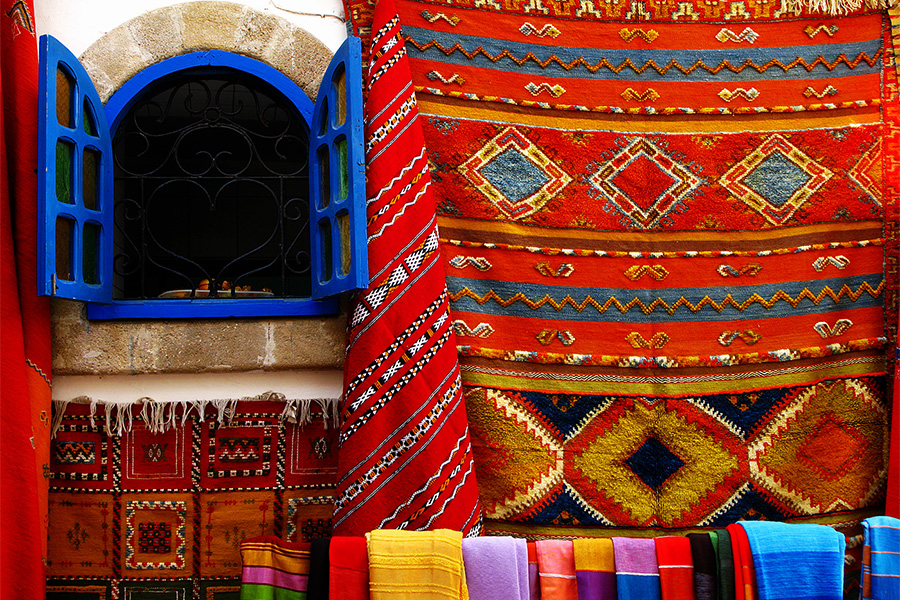Non Western Art
Art in Morocco
Moroccan art is known for it's unusual shapes and patterns, eclectic style, and bright colors. Art takes many forms in Morocco, including ceramics, zellige tiles, calligraphy, wooden crafts, painting, metalwork, jewelry, leatherwork, carpets, textiles, and more. The arts in Morocco evolved over time, with influences from India, Italy, Sweden, France, the Mediterranean region, Pan-African, and North African regions. What we see today is a distinctive collection of art that is very much a local style with global influences.
Chaibia Talal
Chaibia Talal
Mon Village, Chtouka,1990. Oil on canvas. 190 x 191 cm.
Chaibia Talal was a self-taught painter in Morocco. She started out as a widowed mother by the age of 15, but became a local legend. Chaibia believed that she was pre-destined to become a painter after two separate encounters with destiny. The legend goes that she was told by a blind and deaf woman in a Muslim sanctuary that she had a hidden talent. Shortly thereafter, she dreamed that voices were telling her to pick up a paintbrush and paint. The next day, she did just that, but with her fingers. Her son was an artist, and she used his studio to paint. She was discovered by an art curator who encouraged her to display her work, which she did, gaining international acclaim. Talal's work here is interesting, colorful, and full of various geometric lines and shapes. I love how one of the figures bleeds into the next, alluding to a sense of closeness and intimacy between them. They seem to know each other well and are huddled together seemingly gazing at something in the distance. Their facial expressions appear somewhat foreboding and if you look at the top, it even appears that there is an evil eye built into the frame. The evil eye is an important cultural symbol in Morocco and is typically seen as a force that tracks your steps and something that brings bad luck - something to be warded off. It's interesting that Talal included the evil eye here - is it tracking the women in the frame or someone off in the distance? What are the women gazing at? It's certainly open to interpretation!
Malika Agueznay
Malika Agueznay
Composition, 1986. Mixed media on canvas. 120 x 87 cm.
Malika Agueznay is a contemporary Moroccan painter, sculptor, and engraver. She was born in Marakesh and currently resides in Casablanca. She is revered as a pioneer in her field, taking part in the development of abstraction and taking part in defining Moroccan Modernity and developing curriculum in Casablanca. In this piece of mixed media, we see her use of traditional Moroccan colors with layers of geometric shapes one on top of the other. Her use of mixed media provides a sense of depth to the viewer, with the foreground appearing to have white crested waves. The waves are interesting, organic, and textured, begging the viewer to reach out and touch them. Agueznay is known for her recurring seaweed motifs and this piece begs the question - are we looking at waves or are we looking at seaweed? Another thought provoking piece here.
Ali Maimoun
Ali Maimoun
Untitled, 2016. Mixed media and sawdust paste on wood panel. 180 x 134 cm.
Ali Maimoun use of mixed media here lends a sense of depth to his work. The darker background contributes to the illusion of depth by helping the yellow sawdust figures to pop out and greet the viewer. The lines are at once organic and geometric, both traditionally seen in Moroccan art. The bright yellow brush strokes are contrasted by the darker yellow tones and there is a sense of culture and tradition here. Maimoon started out as a trained mason, dabbled in stone sculpture, and ultimately has been led to painting. His work is rooted in mythology and a lot of his works represent figures seemingly engaged in a trance-like state, as we see here in this piece. It's quite incredible to think that these figures are colored in sawdust, especially with all of the variations of color.






Comments
Post a Comment